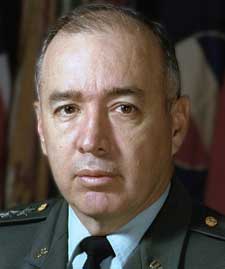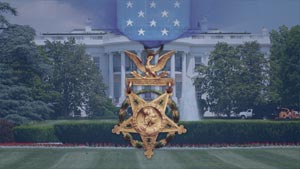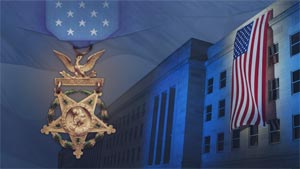MEDAL OF HONOR
Korean WarGeneral Richard E. Cavazos

hometown
Kingsville, Texas
Date of Commission
June 1951
Military Occupation (MOS)
Infantry Officer (11A)
Unit
Company E, 2nd Battalion, 65th Infantry Regiment, 3rd Infantry Division
Deployments
Korean War, 1953; Vietnam War, 1967
Richard Edward Cavazos was born on Jan. 31, 1929, in Kingsville, Texas, and grew up on a cattle ranch. Born to Mexican-American parents, Cavazos spent his childhood following in the footsteps of his World War I veteran-turned-ranch foreman father. Despite growing up in an era of intense racism, Cavazos’ parents managed to put all of their children through college, an unheard-of accomplishment for most Mexican-American families at that time. Cavazos attended Texas Technological College, now Texas Tech University, on a football scholarship until he broke his leg his sophomore year. After his recovery, Cavazos continued his education through the school’s ROTC program and graduated with distinction. In 1951, he was commissioned into the Army and completed basic officer training at Fort Benning, Georgia, now Fort Moore.
He was then deployed to Korea, where he was selected as platoon leader of E Company, 2nd Battalion, 65th Infantry Regiment. Known as the Borinqueneers, the 65th Infantry had been in Korea since the start of the war and was primarily made up of Soldiers from Puerto Rico, many of whom only spoke Spanish. Cavazos, who was raised bilingual, was a welcome addition after a series of commanders who spoke no Spanish, which resulted in confusion and chaos during battles.
Throughout his time in the Army, Cavazos believed that troops needed to have complete trust and faith in their commanding officer to achieve victory. As an example of his leadership, in February 1953, Cavazos, at first leading a few of his men and then going on alone once under attack by enemy fire, captured a wounded enemy soldier who had been left behind after an earlier skirmish. Cavazos was awarded a Silver Star for his bravery.
In June 1953, Cavazos’ leadership abilities were once again on display. He led his men on an assault of the enemy-held Hill 412 as part of a maneuver to cover Outpost Harry, an important defensive position near the hill. They soon came under heavy enemy artillery fire, which resulted in many American casualties. After successfully defending Outpost Harry through three intense hours of fighting, Cavazos received the order to return to friendly lines. Refusing to leave fallen and wounded American Soldiers behind, he repeatedly went back to rescue men, despite being wounded himself. His actions led to the Army awarding him the Distinguished Service Cross.
Cavazos rotated back to the United States in the fall of 1953, where he was stationed at Fort Hood, Texas, now Fort Cavazos. After rising to the rank of lieutenant colonel, he was sent to Vietnam in 1967. There he became the commander of the 1st Battalion, 18th Infantry Regiment. His style of leadership was immediately noticed by his troops.
“He was an atypical army officer in Vietnam,” remembered Bill Fee, who served under him. “Most battalion commanders stood in the rear or in a helicopter above to direct the battle … [He] had nothing to do with that. He fought on the ground with his troops during battle … he was on the ground with us as we were facing the North Vietnamese Army.”
 Then-1st Lt. Richard E. Cavazos sometime in the 1950s when stationed at then-Ford Hood attached to the 25th Armored Infantry Battalion, 1st Armored Division. Courtesy photo.
Then-1st Lt. Richard E. Cavazos sometime in the 1950s when stationed at then-Ford Hood attached to the 25th Armored Infantry Battalion, 1st Armored Division. Courtesy photo.
Another testament to Cavazos’ loyalty to his men and their safety was when he organized a counterattack against enemy forces near Loc Ninh. He once again disregarded his personal safety and led an assault on the enemy’s hillside position, often exposing himself to hostile fire while moving among his troops. He directed such a barrage of artillery fire toward Viet Cong insurgents that the enemy soon fled. This counterattack led the Army to award him a second Distinguished Service Cross.
Cavazos is also remembered as a beloved mentor and teacher. His determination to share what he had learned throughout his career made him influential in the development of the Army’s Battle Command Training Program for high-ranking officers. Soldiers from all walks of life, including General Colin Powell, credited Cavazos for inspiring them to stay in the Army. “I told him what he meant to us poor Hispanic kids,” recalled Maj. Gen. Alfred Valenzuela. “His impact as a mentor is probably the greatest impact our Army had … we all looked up to him as an American soldier, a Hispanic soldier. He was the guy we wanted to be. If we couldn’t be him, we wanted to be near him and serve with him.” Cavazos retired from the Army in 1984 after 33 years of service. Before his retirement, he made military history when the Army appointed him as the first Hispanic brigadier general in 1976 and then four-star general in 1982. Richard E. Cavazos passed away in 2017 at the age of 88 due to complications from Alzheimer’s.
 Then-Maj. Gen. Richard E. Cavazos conducts a change of command ceremony. Courtesy photo.
Then-Maj. Gen. Richard E. Cavazos conducts a change of command ceremony. Courtesy photo.
The Battle
Leaving No One Behind
June 14-15, 1953 | Vicinity of Sagimak, Korea

3rd Infantry Division
Shoulder sleeve insignia of the 3rd Infantry Division, consisting of three white stripes upon a blue square. Read Full Unit History
Then-1st Lt. Richard E. Cavazos distinguished himself by acts of gallantry and intrepidity above and beyond the call of duty, while serving as the commander of Company E, 2nd Battalion, 65th Infantry Regiment, 3rd Infantry Division, on June 14-15, 1953, in the vicinity of Sagimak, Korea. On the night of June 14, Cavazos led his company during a raid on an entrenched enemy outpost with the mission of destroying the personnel and installation.
During the initial attack, Cavazos led his men through intense enemy mortar and artillery fire. Upon entering the trenches, fierce close combat ensued, and Cavazos directed heavy fire on the enemy and their positions. When an extremely intense enemy mortar and artillery barrage hit his position, Cavazos withdrew the company and regrouped his men. Twice more he led his men through intense enemy fire during assaults on the enemy position, destroying vital fortifications and personnel. During the entire assault, Cavazos gave effective commands and words of encouragement to his men and inspired them to heroic heights of achievement through his personal example and leadership.
When ordered to withdraw his company, Cavazos complied but remained alone on the enemy outpost to search for missing men. While exposed to enemy fire, he located five casualties and evacuated them, one by one, to a point on the reverse slope of a nearby hill where they could be safely recovered by friendly forces.
Returning to the battlefield, he found a small group of men who had become separated from the main assaulting force and personally led them to safety. When informed that men were still missing, Cavazos again returned to the scene of the battle and led another small group of men to safety.
Cavazos then made two more unassisted trips to the battlefield, searching for missing soldiers. When he was satisfied that the battlefield was cleared on the morning of June 15, he finally allowed his own combat wounds to be treated.
Cavazos later became the first Hispanic brigadier general in 1976, and was promoted to four-star general in 1982.
Then-1st Lt. Cavazos' conspicuous gallantry, extraordinary heroism and intrepidity at the risk of his life, above and beyond the call of duty, are in keeping with the highest traditions of military service and reflect great credit upon himself, his unit and the United States Army.
RELATED STORIES FROM ARMY.MIL
3rd Infantry Division

3rd Infantry Division
The three white stripes of the insignia are symbolic of the three major operations in which the division participated during World War I. The blue field symbolizes the loyalty of those who placed their lives on the altar of self-sacrifice in defense of the American ideals of liberty and democracy.
The 65th Infantry Regiment constituted on March 2, 1899, in the volunteer Army as the Puerto Rico Regiment of Volunteer Infantry after the United States took control of Puerto Rico following the Spanish-American War. The two-battalion unit was tasked with keeping the peace after the Spanish colonial administration's withdrawal.
The unit was reorganized and redesignated in 1900 as the Puerto Rico Regiment of Volunteer Infantry, with headquarters at San Juan; in 1901 as the Puerto Rico Provisional Regiment of Infantry; and in 1908 as the Puerto Rico Regiment of Infantry, which was allotted to the regular Army.
Initially composed primarily of Puerto Rican enlisted men led by white officers, native Puerto Ricans began joining the regiment's complement of officers after its incorporation into the regular Army; by 1909, 11 Puerto Ricans held commissions as first and second lieutenants.
As World War I approached, the regiment was bolstered by a third battalion, a machine-gun company and a regimental supply company. After America entered the war, the Puerto Rico Regiment of Infantry was assigned to defend the Panama Canal.
The regiment was redesignated the 65th Infantry on Sept. 14, 1920. During World War II, the 65th Infantry served in a homeland defense role from 1943 to 1944, primarily in the Panama Canal Zone. During this time, Col. Antulio Segarra took command of the regiment, becoming the first Puerto Rican regular Army officer to command a regular Army regiment.
The 65th arrived in North Africa on April 5, 1944, and began preparing to enter the European Theater; various components were dispatched to Italy and France in 1944 and 1945. Although, it primarily served in non-combat security roles during its service in Europe, a detachment of the regiment saw limited combat while holding a frontline sector on the Franco-Italian border. The regiment returned to Puerto Rico on Nov. 9, 1945, and its soldiers collectively earned one Distinguished Service Cross, two Silver Stars and 90 Purple Hearts.
After World War II, the 65th Infantry Regiment was reorganized into a regimental combat team. Its post-war tranquility was short-lived, and after the outbreak of the Korean War, it was assigned as the 3rd Infantry Division's third maneuver regiment. During the long voyage to Korea in September 1950, the regiment's men created a unit nickname — the Borinqueneers — in homage to the indigenous Taino name for Puerto Rico.
Although it had been mainly restricted to support missions during World War II, necessity quickly thrust the 65th into combat. The Borinqueneers conducted themselves admirably during the breakout from the Pusan Perimeter and the subsequent advance northwards.
With the counterassault of a massive Chinese force soon thereafter, the 65th participated in the Eighth Army's fighting retreat. The 65th elements attached to Task Force Dog covered the Marine withdrawal at the Chosin Reservoir, and the regiment defended the critical port of Hungnam while battered U.N. forces used it as an evacuation route.
Returning to Pusan, the 65th fought its way northwards again, proving their mettle during the recapture of Seoul in early 1951. On Feb. 2, the 65th's 1st and 2nd Battalions executed the last battalion-sized bayonet charge in Army history, routing Chinese forces occupying two strategically vital hills near the South Korean capital. Through the remaining two years of the war, the Puerto Ricans of the 65th remained an integral part of U.N. efforts to hold the line at the 38th Parallel.
Despite the cultural-linguistic barrier that separated them from the rest of the Army and the frigid climate that so vastly differed from their sub-tropical home island, the Borinqueneers proved their valor by earning a Medal of Honor, 10 Distinguished Service Crosses, 256 Silver Stars, 606 Bronze Stars and 2,771 Purple Hearts during the Korean War.
After the war's end in 1953, the 65th remained in Korea until it was relieved of its assignment on Nov. 3, 1954. It returned to Puerto Rico later that month and was reassigned to the 23rd Infantry Division on Dec. 2, 1954. It was inactivated on April 10, 1956, and was withdrawn from the regular Army on Feb. 6, 1959. It was then allotted to the Puerto Rico Army National Guard as an element of the 92nd Infantry Brigade, where it remains to this day. After a long period at home in Puerto Rico, elements of the 65th were federalized and deployed to Africa and the Middle East during the Global War on Terrorism. The Borinqueneers' accomplishments were formally recognized when the regiment received the Congressional Gold Medal in 2016.

